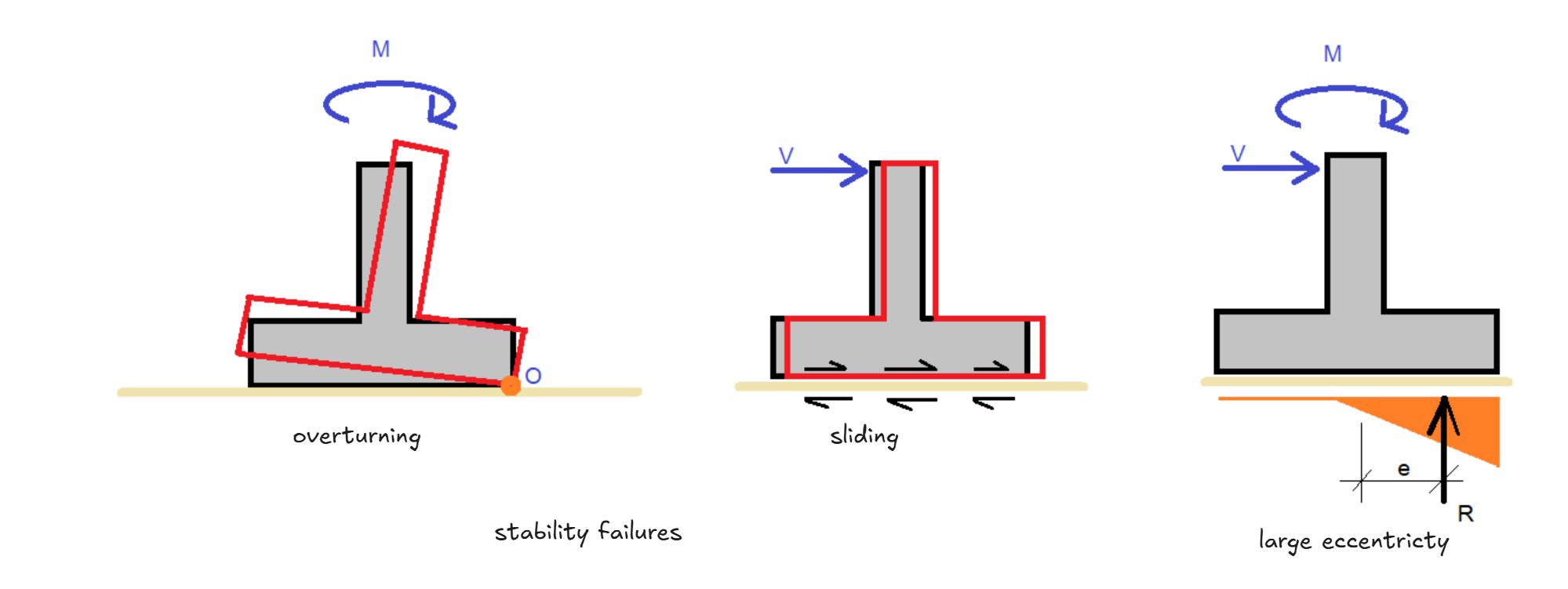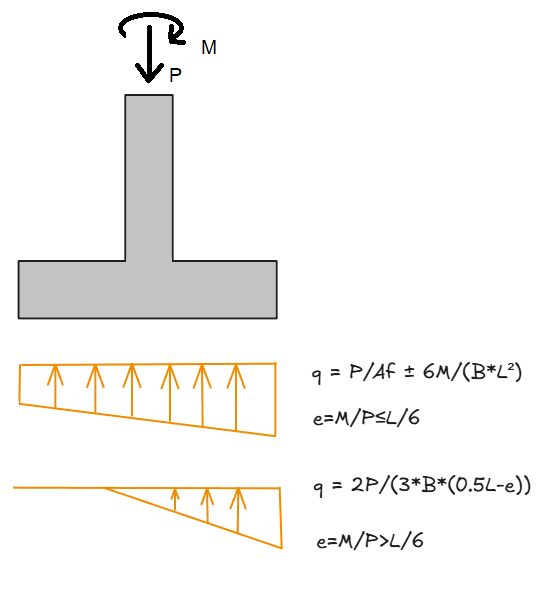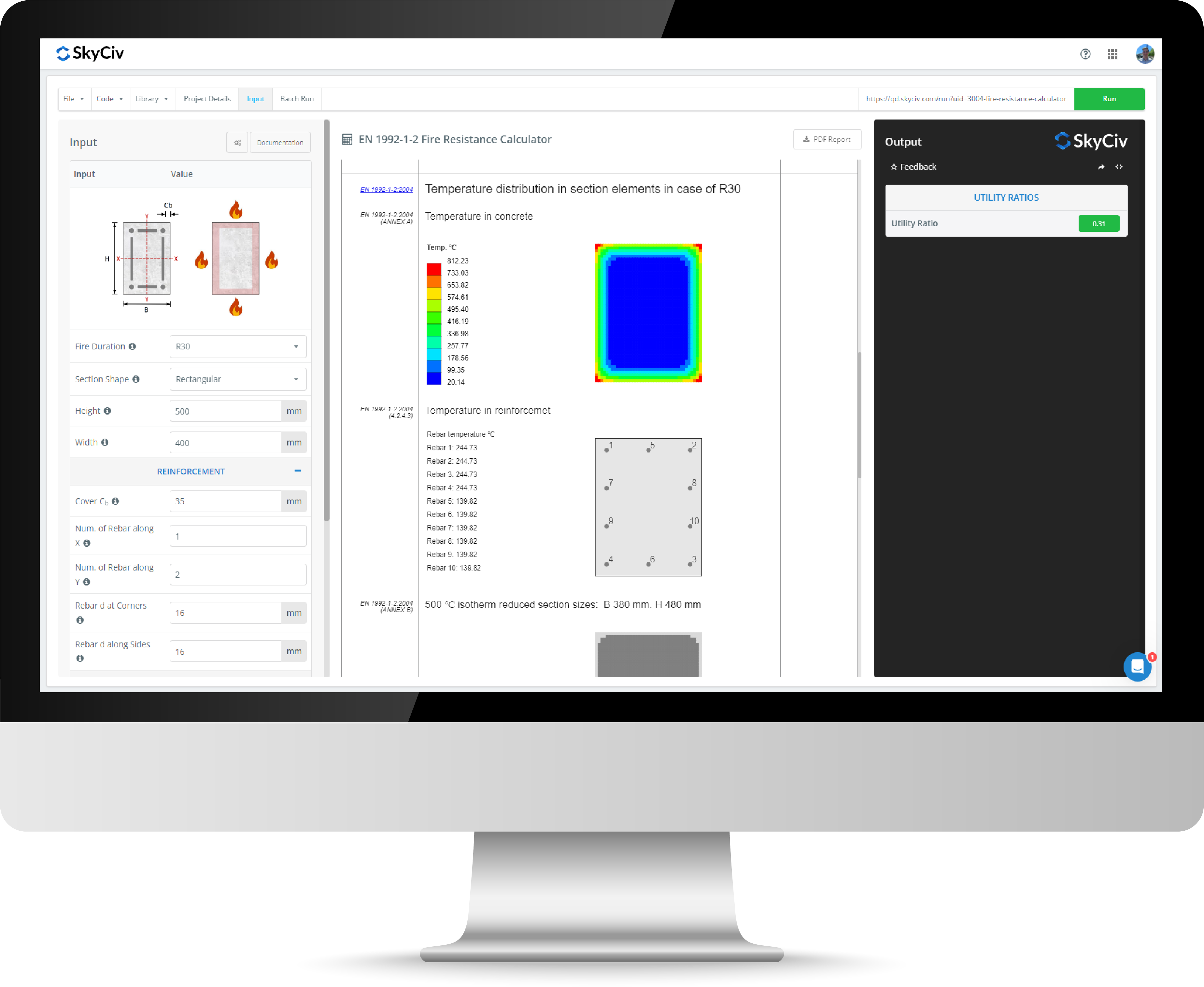Calculadora de diseño de zapatas de tiras de hormigón armado
Las zapatas corridas son esenciales para soportar las cargas del edificio y distribuirlas de forma segura al suelo.. Como tipo fundamental de cimentación poco profunda., Son ampliamente utilizados debido a su eficiencia y simplicidad en la construcción.. En ingeniería estructural, Seleccionar y diseñar las zapatas correctamente es crucial para garantizar tanto la seguridad como la viabilidad económica de las estructuras..
La Calculadora de zapatas corridas SkyCiv debe usarse para el análisis y diseño de zapatas corridas según el ACI. 318-19 Estándar de diseño. Las comprobaciones utilizadas en la calculadora siguen los requisitos del Capítulo 13 del Código ACI relacionado con zapatas continuas. La herramienta de diseño de zapatas continuas puede trabajar tanto con zapatas de hormigón armado como con zapatas de hormigón en masa de acuerdo con los requisitos del Capítulo 14 del ACI 318 Estándar. Este módulo es parte del Biblioteca de diseño rápido de SkyCiv.
Tabla de Contenidos
Acerca de la calculadora de diseño de zapatas corridas SkyCiv
Definición de zapata corrida: ¿Qué es una zapata corrida??
Una zapata corrida es una zapata continua., Cimentación de hormigón alargada que soporta cargas estructurales lineales., normalmente debajo de muros de carga. Transfiere la carga desde la pared a una capa de suelo ubicada relativamente cerca de la superficie del suelo.. Este tipo de zapata distribuye cargas concentradas de la superestructura sobre un área más amplia de suelo., reducir la presión y mitigar los riesgos de liquidación. La capa de suelo debe tener una capacidad de carga adecuada y una profundidad suficiente para evitar las heladas y otros problemas ambientales..
¿Cuándo se deben utilizar zapatas corridas??
Las zapatas corridas son las más adecuadas para estructuras con muros., como edificios residenciales, escuelas, e instalaciones comerciales ligeras. Son ideales cuando el suelo tiene una capacidad de carga adecuada a poca profundidad., y las cargas impuestas son moderadas y uniformemente distribuidas. Las aplicaciones comunes incluyen soporte de mampostería o paredes de concreto., columnas continuas, y situaciones en las que las zapatas aisladas no son prácticas debido a la geometría de la pared o la distribución de la carga..
Tipos de zapatas corridas
Típicamente, Se utilizan dos tipos de zapatas corridas.:
- Zapatas de tiras de hormigón liso - que son ideales para estructuras más ligeras y edificios de poca altura con suelos estables..
- Zapatas de listones de hormigón armado - que se utilizan para cargas más pesadas o cuando se requiere una mayor durabilidad debido a las condiciones ambientales. Son adecuados para estructuras más pesadas donde la capacidad de carga del suelo es relativamente baja..
Refuerzo de zapata corrida
El refuerzo de flexión generalmente se coloca en la parte inferior de la zapata., perpendicular a la cara de la pared. En la dirección transversal, El refuerzo de contracción y temperatura debe proporcionarse paralelo a la longitud de la pared..
Carga de zapatas corridas
Las zapatas corridas suelen soportar cargas lineales debajo de los muros de carga.. sin embargo, en algunos casos, una línea de columnas estrechamente espaciadas también puede estar sostenida por una zapata corrida.
Modos de falla para zapatas corridas
Los modos de falla de zapatas corridas generalmente se pueden clasificar en tres categorías: fallas en el soporte del suelo, fallas de estabilidad, y fallas estructurales. Estos se ilustran en la siguiente figura..


Figura 1: Modos de falla de zapata corrida
Procedimiento de diseño de zapatas corridas (ACI 318-19)
El diseño de zapatas corridas involucra varios pasos debido a los diversos parámetros y variables que afectan las dimensiones y características finales..
Paso 1: Investigación y consideraciones geotécnicas.
El diseño de cimentaciones generalmente requiere determinar el comportamiento y la deformabilidad relacionada con la tensión del suelo debajo de la cimentación.. Lograr esto, Se deben determinar las propiedades geotécnicas del suelo.. Estas propiedades incluyen la distribución del tamaño de grano., clasificación del suelo, plasticidad, compresibilidad, y resistencia al corte. La investigación tiene como objetivo determinar la idoneidad de diferentes tipos de cimentaciones y la capacidad portante del suelo.. Este proceso normalmente incluye la realización del cálculo de la capacidad de carga última y un análisis de asentamiento.. Estos pasos determinan la presión de rodamiento permitida. (qa) para evitar fallas en el soporte del suelo. Si una base de tira es adecuada, El ingeniero puede entonces proceder al siguiente paso..
Paso 2: Comprobaciones de estabilidad
Asegúrese de que el sistema de cimentación sea seguro contra vuelcos., deslizamiento, y evitar la elevación excesiva debido a excentricidades.
Paso 3: Definir el área base
en los estados unidos, Esto se determina utilizando las combinaciones de tensión permitida y carga de servicio.. Los valores presuntivos de carga (Mesa IBC 1806.2) También se puede utilizar si está permitido.. La tensión admisible normalmente se incluye en el informe geotécnico., considerando la capacidad portante y los posibles asentamientos. En una zapata desnuda, la tensión del suelo para una zapata con una carga axial (PAG) y momento (M) se puede calcular como se muestra en la Figura 2.

Figura 2: Cálculos de tensión del suelo en zapatas continuas
Paso 4: Definir el espesor de la base y calcular el refuerzo de flexión
Esto normalmente se hace mediante un procedimiento de prueba y error para evitar cualquier falla estructural.. En este caso, se adopta un espesor de zapata, y luego se verifica la resistencia a la flexión y al corte.. en este paso, La zapata debe diseñarse para momentos de flexión., cizalla unidireccional (El corte en dos direcciones no es aplicable para zapatas continuas.) causado por la presión del suelo debido a cargas factorizadas. Una profundidad mínima de 6 en debe ser considerado (ACI 318-19 c13.3.1.2) y un recubrimiento mínimo de hormigón igual a 3 para hormigón vaciado contra el suelo y en contacto permanente con él (ACI 318-19 c20.5.1.3.2). También es importante considerar el espesor mínimo de zapata en función del desarrollo de las barras que parten desde la zapata hasta el muro para muros de concreto..
Si se analiza el diagrama de momento flector (ver figura 2), Parece que el momento máximo en la zapata corrida ocurre debajo del medio del muro., pero las pruebas han demostrado que esto no es correcto debido a la rigidez de las paredes. El código ACI sugiere (ACI 318-19, c13.2.7.1) calcularlo en la cara del muro para muros de hormigón armado o en una sección a medio camino desde la cara del muro hasta su centro para muros de mampostería. en los cálculos, sólo se requiere considerar la presión hacia arriba causada por las cargas externas aplicadas a la zapata. Se debe despreciar el peso propio y el peso del suelo sobrecargado.. Sólo se deben utilizar las presiones netas sobre la zapata para el diseño estructural..

Figura 3: Diagramas de corte y momento para una zapata de muro con presiones uniformes en el suelo
Si la zapata del muro se carga hasta que falla en corte, la falla no ocurrirá en un plano vertical en la cara de la pared sino en un ángulo de aproximadamente 45° con la cara de la pared, por lo tanto la sección crítica para corte se calcula a una distancia “d” de la cara (ACI 318-19c13.2.7.2), siendo “d” la profundidad efectiva, ver figura 3. La profundidad efectiva se calcula como:

donde h es el espesor de la losa de zapata, c es la portada, y db es el diametro de la barra.
Una vez alcanzado el momento flector máximo (Mtu) en la sección crítica se ha determinado, el área requerida de refuerzo (As) se determina de la misma manera que cualquier miembro a flexión. Aunque una zapata no es una viga, es deseable que sea dúctil a la flexión, y esto se puede hacer limitando la deformación neta de tracción en el refuerzo de tensión (mit) a un valor mayor que εty + 0.003 (ACI 318-19 c21.2.2, mity es igual a fy/Es).
Con el supuesto anterior, El área de refuerzo requerida se puede calcular con las siguientes ecuaciones.

b es el ancho de la sección, F'do es la resistencia a la compresión especificada del hormigón, Fy es el límite elástico especificado del refuerzo, y Es es el módulo de elasticidad del refuerzo de acero.
La resistencia al corte normalmente se calcula sólo considerando la contribución del hormigón.. No es aconsejable utilizar refuerzo de corte debido al aumento de costos.. Por lo tanto, El corte calculado en la sección de corte crítica debe ser mayor que la resistencia resistida por el concreto.. Se calcula utilizando la ecuación dada en la tabla. 22.5.5.1(c) (ACI 318-19 c22.5.51)

donde ρw es la relación de refuerzo igual a As/(b×d), λ es el factor de modificación para reflejar las propiedades mecánicas reducidas del hormigón ligero., y ϕ es el factor de reducción de corte.
Una vez que se confirma que el espesor de la zapata resiste la flexión y el corte en un sentido, y el refuerzo adoptado es mayor que el requerido, podemos continuar con el siguiente paso.
Paso 5: Calcular las fuerzas de transferencia
Se deben verificar las fuerzas verticales y horizontales transferidas a la zapata por el soporte del concreto o una combinación de soporte y refuerzo de interfaz.. Este requisito se detalla en la Sección 22.8 del ACI 318-19:

Donde un1 es el área cargada, A2 es el área de la base inferior del tronco más grande de una pirámide, cono. Los lados de la pirámide, cono, o la cuña cónica deberá estar inclinada 1 vertical a 2 horizontal. Y ϕ es un factor de reducción.
Paso 5: Detallando cheques
El último paso está dedicado a los detalles del refuerzo como espaciado mínimo y máximo., Longitud de desarrollo hasta secciones críticas.. Los detalles se dan en el Capítulo 25 de ACI 318-19.
tira vs. Zapatas de pared
Las zapatas de muro son esencialmente un subconjunto de zapatas corridas y a menudo se usan indistintamente., ya que ambos describen un continuo, Zapata estrecha que soporta cargas lineales.. sin embargo, Las zapatas corridas tienen una definición más amplia y también pueden soportar una línea de columnas estrechamente espaciadas., aceptar cargas puntuales dispuestas en fila. En términos de refuerzo, ambos tipos son similares.
Zapatas corridas frente a zapatas extendidas o almohadilladas
Las zapatas corridas están estrechamente relacionadas con zapatas extendidas, ya que ambos son tipos de cimentaciones poco profundas comúnmente utilizadas en estructuras pequeñas y medianas debido a su bajo costo.. Las zapatas corridas suelen ser largas y rectangulares., mientras que las zapatas pueden ser cuadradas, rectangular, o circular. Las zapatas corridas generalmente soportan cargas lineales., mientras zapatas de almohadilla soportar cargas concentradas. en diseño, Todas las comprobaciones realizadas para zapatas corridas también deben aplicarse a zapatas planas o planas., con controles adicionales como el cortante bidireccional (puñetazos) controlar.
Cómo utilizar la calculadora de zapatas de muro?
La herramienta de zapata de muro funciona con una filosofía de prueba y error.. El usuario puede modificar los datos de entrada hasta que pasen todas las comprobaciones.. Normalmente cuando hay fallas, la solución pasa por ampliar la zapata o incrementar el refuerzo. En todo caso, La herramienta también verifica las condiciones mínimas y máximas que ayudan a evitar un refuerzo excesivo.. Se sugiere aumentar la altura para fallas por corte., ampliar el ancho para fallas de estabilidad, e incrementar el área de refuerzo para fallas por flexión cuando la altura de la zapata y las comprobaciones de corte estén bien..
Puntos clave - Zapatas corridas
- Las zapatas corridas son económicas y se utilizan ampliamente para cimentaciones poco profundas..
- Una investigación geotécnica adecuada es esencial.
- El diseño debe abordar el soporte del suelo., asentamiento, fuerza estructural, y estabilidad.
- Seguir ACI 318-19 para todos los controles y detalles.
Referencias
- ACI 318-19: Requisitos del Código de Construcción para Hormigón Estructural
- Mesa IBC 1806.2: Valores presuntivos de carga
- CRSI, Guía de diseño en el ACI 318 Requisitos del Código de Construcción para Hormigón Estructural, CRSI (2020).
- Concreto reforzado: Mecánica y Diseño 6ta Edición por James K. Criatura, James G. MacGregor.
Preguntas Frecuentes
¿Qué ángulo de fricción entre cimientos y suelo se debe utilizar??
Este ángulo normalmente está entre la mitad y dos tercios del ángulo de fricción del suelo.. ("Principios de la ingeniería de cimientos" de Braja M. los)
¿Qué factores de reducción se utilizan en las verificaciones de resistencia??
La calculadora de zapatas continuas de ACI utiliza φ = 0.75 para cortar, ϕ = 0.90 para doblar (para hormigón armado, asumiendo una condición de tensión controlada que involucra un área de refuerzo menor que el límite máximo para esta condición), ϕ = 0.60 para doblar hormigón simple, y φ = 0.65 para rodamiento.
¿Qué valor se utiliza para el peso unitario del hormigón? ?
El valor predeterminado utilizado es 150 lb/ft3 según lo sugerido por la norma para concreto de peso normal.
¿Qué valor de peso unitario del suelo se puede utilizar??
Los valores comunes están entre 90 a 130 lb/pie3. Se recomienda utilizar el valor húmedo sugerido en el informe geotécnico del proyecto..
¿Se utiliza el refuerzo de la pared en los cálculos??
no se usa, sólo para fines de dibujo. los tacos de la pared, sin embargo, Se utilizan en la verificación de transferencia de fuerzas de carga..
¿Por qué mi pie tiene un espacio máximo pequeño??
El ACI 318-19 Sección de 24.3.2 especifica valores bastante bajos considerando los valores utilizados para el recubrimiento de hormigón (normalmente alrededor 3 pulgadas). Algunas referencias (Evitar usos problemáticos de losas en el suelo, ene, 2021 Revista Estructura de Alexander Newman, EDUCACIÓN FÍSICA., F.) Mencione que el ACI debería considerar eximir estas disposiciones para zapatas y losas en el suelo., pero, a partir de ahora, todavía aplican, y por lo tanto están incluidos en el programa.
- Diseño rápido SkyCiv
- Calculadora de capacidad de carga
- ACI 360 Calculadora de diseño de losa sobre rasante
- Calculadora de zapata extendida
- Calculadora de Diseño de Pilotes de Tornillo
- AS 2870 Calculadora de diseño de losa sobre rasante
- Calculadora de estabilidad de la pila lateral
- Calculato de diseño de columna de hormigón armador
Acerca SkyCiv
SkyCiv ofrece una amplia gama de Software de Análisis y Diseño Estructural en la Nube para ingenieros. Como una empresa tecnológica en constante evolución, estamos comprometidos con la innovación y desafiando los flujos de trabajo existentes para ahorrar tiempo a los ingenieros en sus procesos de trabajo y diseños.



